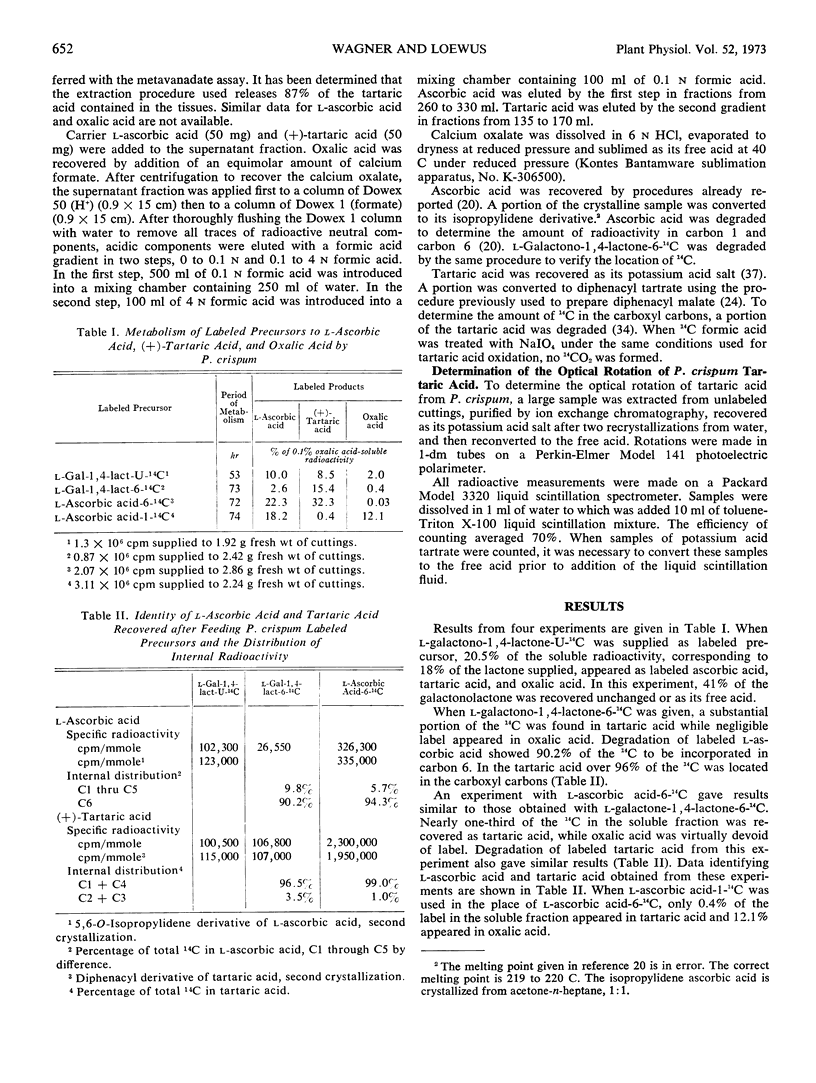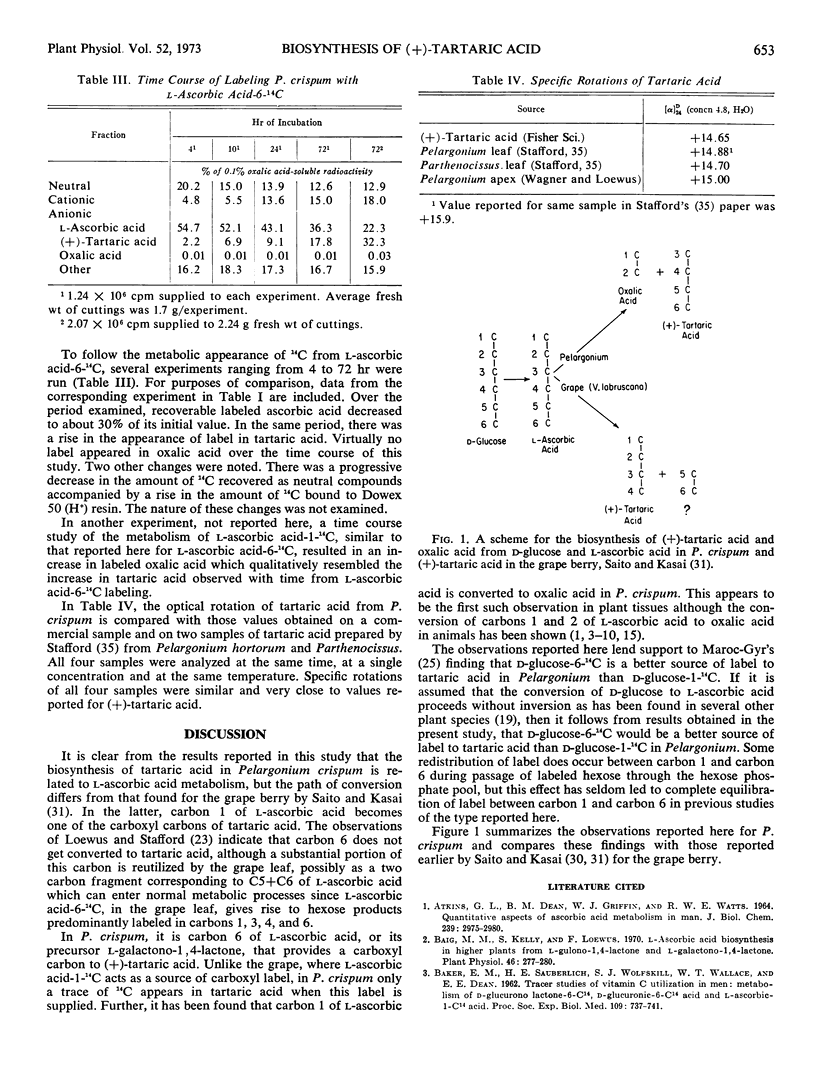Abstract
Metabolic conversion of l-galactono-1, 4-lactone and l-ascorbic acid to (+)-tartaric acid and oxalic acid has been studied in Pelargonium crispum, cv. Prince Rupert. Experiments with specifically labeled substrates suggest a path of conversion involving cleavage of l-ascorbic acid, or a metabolic product of l-ascorbic acid, between C2 and C3, such that oxalic acid arises from the two carbon fragment and (+)-tartaric acid from the four carbon fragment.
Full text
PDF



Selected References
These references are in PubMed. This may not be the complete list of references from this article.
- ATKINS G. L., DEAN B. M., GRIFFIN W. J., WATTS R. W. QUANTITATIVE ASPECTS OF ASCORBIC ACID METABOLISM IN MAN. J Biol Chem. 1964 Sep;239:2975–2980. [PubMed] [Google Scholar]
- BURNS J. J., BURCH H. B., KING C. G. The metabolism of 1-C14-L-ascorbic acid in guinea pigs. J Biol Chem. 1951 Aug;191(2):501–514. [PubMed] [Google Scholar]
- BURNS J. J., DAYTON P. G., SCHULENBERG S. Further observations on the metabolism of L-ascorbic acid in guinea pigs. J Biol Chem. 1956 Jan;218(1):15–21. [PubMed] [Google Scholar]
- Baig M. M., Kelly S., Loewus F. L-ascorbic acid biosynthesis in higher plants from L-gulono-1, 4-lactone and L-galactono-1, 4-lactone. Plant Physiol. 1970 Aug;46(2):277–280. doi: 10.1104/pp.46.2.277. [DOI] [PMC free article] [PubMed] [Google Scholar]
- CHAN P. C., BECKER R. R., KING C. G. Metabolic products of L-ascorbic acid. J Biol Chem. 1958 Mar;231(1):231–240. [PubMed] [Google Scholar]
- CURTIN C. O., KING C. G. The metabolism of ascorbic acid-1-C14 and oxalic acid-C14 in the rat. J Biol Chem. 1955 Oct;216(2):539–548. [PubMed] [Google Scholar]
- DAYTON P. G., EISENBERG F., Jr, BURNS J. J. Metabolism of C14-labeled ascorbic, dehydroascorbic and diketoglulonic acids in guinea pigs. Arch Biochem Biophys. 1959 Mar;81(1):111–118. doi: 10.1016/0003-9861(59)90180-8. [DOI] [PubMed] [Google Scholar]
- Dayton P. G., Snell M. M., Perel J. M. Ascorbic and dehydroascorbic acids in guinea pigs and rats. J Nutr. 1966 Mar;88(3):338–344. doi: 10.1093/jn/88.3.338. [DOI] [PubMed] [Google Scholar]
- Dickinson D. B. Rapid starch synthesis associated with increased respiration in germinating lily pollen. Plant Physiol. 1968 Jan;43(1):1–8. doi: 10.1104/pp.43.1.1. [DOI] [PMC free article] [PubMed] [Google Scholar]
- FINKLE B. J., KELLY S., LOEWUS F. A. Metabolism of d-[I-14C]- and d-[6-14C] glucuronolactone by the ripening strawberry. Biochim Biophys Acta. 1960 Feb 26;38:332–339. doi: 10.1016/0006-3002(60)91249-x. [DOI] [PubMed] [Google Scholar]
- HELLMAN L., BURNS J. J. Metabolism of L-ascorbic acid-1-C14 in man. J Biol Chem. 1958 Feb;230(2):923–930. [PubMed] [Google Scholar]
- Hardy P. J. Metabolism of sugars and organic acids in immature grape berries. Plant Physiol. 1968 Feb;43(2):224–228. doi: 10.1104/pp.43.2.224. [DOI] [PMC free article] [PubMed] [Google Scholar]
- JACKSON G. A., WOOD R. B., PROSSER M. V. Conversion of L-galactono-gamma-lactone into L-ascorbic acid by plants. Nature. 1961 Jul 15;191:282–283. doi: 10.1038/191282a0. [DOI] [PubMed] [Google Scholar]
- JANG R., LOEWUS F. A., SEEGMILLER C. G. The conversion of C14-labeled sugars to L-ascorbic acid in ripening strawberries. J Biol Chem. 1956 Oct;222(2):649–664. [PubMed] [Google Scholar]
- Kliewer W. M. Influence of Environment on Metabolism of Organic Acids and Carbohydrates in Vitis Vinifera. I. Temperature. Plant Physiol. 1964 Nov;39(6):869–880. doi: 10.1104/pp.39.6.869. [DOI] [PMC free article] [PubMed] [Google Scholar]
- LOEWUS F. A., TCHEN T. T., VENNESLAND B. The enzymatic transfer of hydrogen. III. The reaction catalyzed by malic dehydrogenase. J Biol Chem. 1955 Feb;212(2):787–800. [PubMed] [Google Scholar]
- Loewus F. A., Stafford H. A. Observations on the Incorporation of C into Tartaric Acid and the Labeling Pattern of D-Glucose from an Excised Grape Leaf Administered L-Ascorbic Acid-6-C. Plant Physiol. 1958 Mar;33(2):155–156. doi: 10.1104/pp.33.2.155. [DOI] [PMC free article] [PubMed] [Google Scholar]
- SEEGMILLER C. G., JANG R., MANN W., Jr Conversion of radioactive hexoses to pectin in the strawberry. Arch Biochem Biophys. 1956 Apr;61(2):422–430. doi: 10.1016/0003-9861(56)90365-4. [DOI] [PubMed] [Google Scholar]
- Stafford H. A., Loewus F. A. The Fixation of CO(2) into Tartaric and Malic Acids of Excised Grape Leaves. Plant Physiol. 1958 May;33(3):194–199. doi: 10.1104/pp.33.3.194. [DOI] [PMC free article] [PubMed] [Google Scholar]
- Vaughn R. H., Marsh G. L., Stadtman T. C., Cantino B. C. Decomposition of Tartrates by the Coliform Bacteria. J Bacteriol. 1946 Sep;52(3):311–325. [PMC free article] [PubMed] [Google Scholar]


